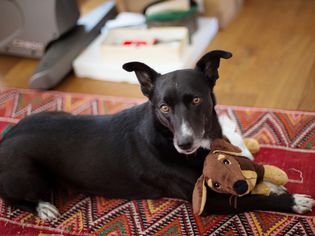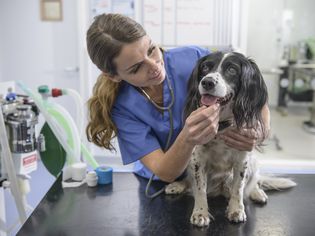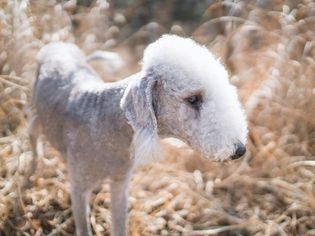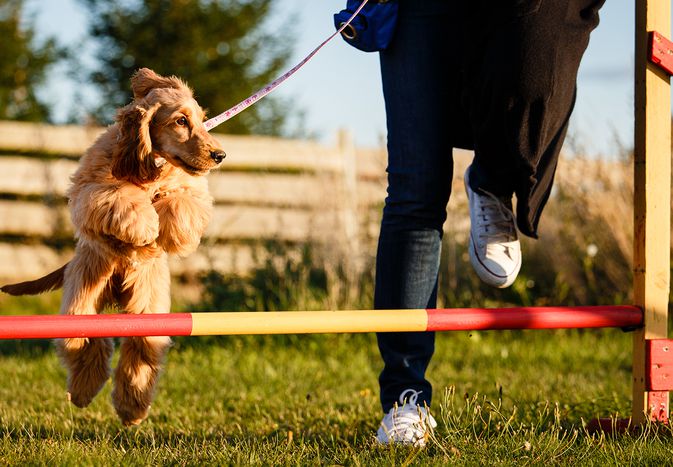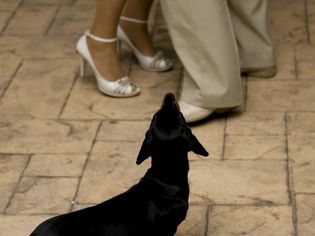The Irish doodle is a cross between an Irish setter and a miniature or standard poodle. These dogs, which fall in the medium to large category, vary in size depending on the size of their parent breed. Mini Irish doodles, which have a miniature poodle parent, will be smaller than those with a standard poodle parent.
These dogs are known for their captivating red, low-shedding coats, which can be wavy or curly. As the offspring of two working breeds, Irish doodles are highly intelligent, energetic, and eager to please, making them ideal companions for active individuals and families.
Here's everything you need to know about the Irish doodle, including their characteristics, care needs, health, and history.
Breed Overview
GROUP: Hybrid
HEIGHT: 22 to 28 inches
WEIGHT: 40 to 70 pounds
COAT: Medium-length; wavy, curly, dense
COAT COLOR: Red (most common), black, black and tan, brown, or white
LIFE SPAN: 10 to 13 years
TEMPERAMENT: Intelligent, affectionate, social, playful, alert
HYPOALLERGENIC: Yes
ORIGIN: United States
Characteristics of the Irish Doodle
Irish doodles are a relatively new hybrid, so they aren’t yet recognized as an official breed by the American Kennel Club and therefore lack breed standard characteristics.
“However, there are some general characteristics that are common and are derived from the two breeds that make up an Irish doodle, the Irish setter and the standard poodle,” says Nell Ostermeier, DVM, CVA, FAAVA, spokesperson for Figo Pet Insurance.
Known for their friendly disposition, high energy levels, and intelligence, Irish doodles make excellent pets for active individuals and families. They also tend to do well in households with children and other dogs, though it’s wise to supervise them around very young children, as their exuberance might accidentally knock them over.
| Affection Level | High |
| Friendliness | High |
| Kid-Friendly | High |
| Pet-Friendly | Medium |
| Exercise Needs | High |
| Playfulness | High |
| Energy Level | High |
| Trainability | High |
| Intelligence | High |
| Tendency to Bark | Medium |
| Amount of Shedding | Low |
History of the Irish Doodle
The Irish doodle is a relatively new hybrid breed, originating from the deliberate crossing of the Irish setter and the poodle. While the exact timeline of the Irish doodle’s creation is unclear, it's believed that this crossbreed started gaining popularity in the U.S. in the early 2000s, coinciding with the rise of designer dogs.
Despite being relatively new to the scene, the Irish doodle’s parent breeds have a much longer history. Irish setters were developed in Ireland in the 18th century to assist bird hunters before the advent of firearms. The Irish doodle’s other genetic half, the poodle, has roots in 14th-century Germany, where hunters used this dog to retrieve ducks.
Irish Doodle Care
Caring for an Irish doodle involves understanding their unique needs to ensure they remain happy, healthy, well-adjusted, and looking sharp.
Exercise
“Because the parent breeds of Irish doodles (the Irish setter and the poodle) generally require significant exercise to maintain their mental well-being, the same is true for the Irish doodle,” says Ostermeier.
Aim for at least an hour of exercise daily to keep your Irish doodle fit and prevent boredom- and anxiety-related behaviors.
According to Ostermeier, Irish doodles’ high intelligence, playful nature, and retrieving background make them especially fond of activities that are both mentally and physically stimulating, such as agility exercises and playing fetch. But they also love walks, jogging, hiking, and swimming.
Grooming
An Irish doodle’s wavy or curly coat is typically low-shedding but does require regular maintenance to prevent matting and tangling. An Irish doodle should ideally be brushed daily.
Additionally, professional grooming should be scheduled every 6 to 8 weeks for a trim and thorough cleaning.
You should also check and clean their ears regularly, trim their nails as needed, and brush their teeth several times a week.
Training
Irish doodles are highly intelligent and love pleasing their guardians, making them relatively easy to train. Start training your Irish doodle from a young age with positive reinforcement techniques (rewarding positive behavior with treats and praise). Consistency and patience are key to successful training, as these dogs can sometimes have a stubborn streak.
Socialization is equally important—expose your Irish doodle to various environments, people, and other animals to help them develop into well-rounded and confident adult dogs. Enroll in puppy training classes to provide structured learning and social interaction opportunities.
Common Health Problems
Irish setters and poodles are generally healthy breeds with long lifespans; Irish setters typically live 12 to 15 years while poodles typically live 10 to 18 years.
However, like all breeds, they’re prone to certain health conditions that may be passed on to their offspring. These might include:
- Hip Dysplasia: This condition occurs when the hip joint doesn’t develop properly, leading to arthritis and pain. Regular veterinary check-ups and maintaining a healthy weight can help manage this condition.
- Progressive Retinal Atrophy (PRA): This inherited disease causes gradual deterioration of the retina, eventually leading to blindness. It’s important to have your Irish doodle’s eyes checked regularly by a veterinarian.
- Bloat: Bloat is a life-threatening condition that is more common in deep-chested breeds like the Irish setter and standard poodle. It occurs when the stomach fills with gas, potentially causing it to twist. If bloat is suspected, immediate veterinary attention is crucial.
- Idiopathic Epilepsy: Idiopathic (of unknown cause) epilepsy is a neurological disorder that can cause seizures. While there is no cure for epilepsy, it can often be managed with medication.
- von Willebrand Disease: This genetic condition is caused by a deficiency in von Willebrand factor, a protein needed for blood clotting. Regular veterinary check-ups and genetic testing can help identify and manage this condition.
“A smart thing to do if you are considering an Irish doodle as your next dog is to research breeders and go with one that provides plenty of information regarding the health history of the parents and the breeding line that your puppy will come from,” says Ostermeier.
Additionally, from puppyhood onwards, take your Irish doodle for regular wellness exams and vaccinations. These are crucial for disease prevention and the early detection of potential health issues. Investing in pet insurance for your puppy can help cover these medical expenses.
Diet and Nutrition
Like all dogs, Irish doodles need a balanced diet that includes proteins, fats, carbohydrates, vitamins, and minerals. Opt for a high-quality commercial dog food that lists meat as the first ingredient.
Follow the portion size instructions on the dog food packaging, or ask your veterinarian for personalized guidance. Most Irish Doodles do well with twice-a-day feedings. If your dog tends to eat too quickly, consider using a slow-feeder dog bowl to help regulate their eating pace.
Where to Adopt or Buy an Irish Doodle
If you’d like to adopt an Irish doodle, check with your animal shelter or rescue group to see if any are available. You can also check Irish doodle-specific rescue groups or online adoption databases like Adopt a Pet.
If you want to purchase an Irish Doodle, research breeders online and ask for recommendations from veterinarians, dog trainers, and other pet parents. It’s important to find an ethical and responsible breeder who promotes the health and well-being of their dogs.
The average price of an Irish doodle from a reputable breeder is between $1,500 and $3,000, depending on the breeder, lineage, location, color, and other factors.
Irish Doodle Overview
Known for their friendly and affectionate nature, Irish doodles are the total package: brains, beauty, and brawn. They’re energetic and require ample exercise, making them an excellent fit for active people. With their wavy or curly, low-shedding coats and captivating red coloring, Irish doodles are not only visually appealing but also great for those with allergies.
Friendly and affectionate
Generally do well with children and other dogs
Highly intelligent and easy to train
May chase smaller pets and wildlife
Require regular grooming
Require a significant amount of daily exercise
More Dog Breeds and Further Research
Before adopting or buying an Irish doodle, consider if their temperament and needs are compatible with your preferences and lifestyle. If you’re interested in Irish doodles, you might also want to research these similar or related breeds:
- Goldendoodle
- Shih-poo
- Bernedoodle
- Are Irish doodles aggressive?
Irish doodles are generally known for being friendly and easy-going, but like any breed, they can have individual temperaments. Like most dogs, an Irish doodle may display aggressive behavior if they feel threatened.
Are Irish doodles good apartment dogs?Due to their size and high energy levels, standard Irish doodles might not be ideal for apartment living due to space limitations. Miniature Irish doodles may do well with apartment living but still require at least an hour of exercise each day.
Do Irish Doodles bark a lot?Irish doodles are generally moderate barkers, meaning they may bark to alert you to something unusual or exciting, but they are not likely to bark incessantly.

